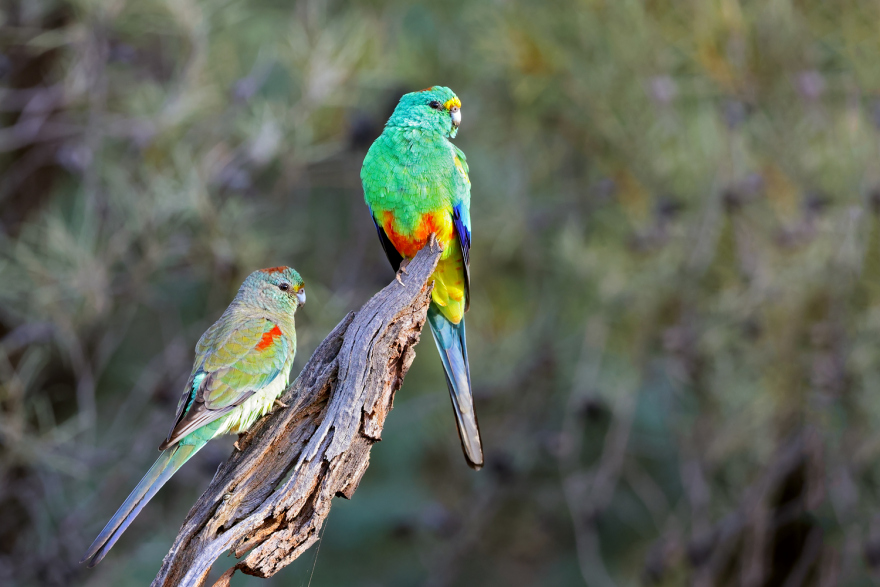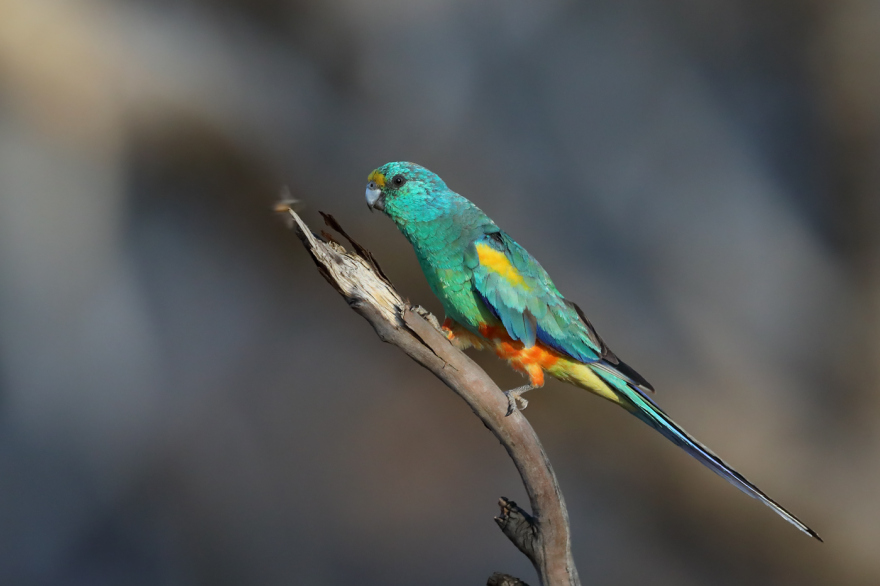Mulga parrots are a medium-sized parrot found in arid regions of southern inland Australia. They can be found in every state except Tasmania. They are uncommon in captivity, but can usually be sourced without too much difficulty. Please note that this species requires a permit in many jurisdictions.

Housing & Compatibility
Mulga parrots should be housed as one pair per aviary, in an aviary that’s at least three metres or longer. Both suspended aviaries and traditional aviaries are suitable housing options.
They are enthusiastic chewers and need to be provided with natural non-toxic branches and perches to provide stimulation. Seeding or flowering branches are especially enjoyed, but will need to be replaced often.
Some mulga parrots can be quite aggressive, so ensure there is double wiring between any adjoining aviaries—especially if housed next to other mulga parrots.
Diet & Feeding
Seed forms the basis of the mulga parrot’s diet. A quality mix designed for small parrots such as lovebirds or budgies will be acceptable. Sprouting seed increases its nutritional value and is a cheap way to improve your bird’s health. Freshly grown green seed heads should also be offered when available.
Mulga parrots require a wide variety of fruit and vegetables to ensure good health. In the wild they typically consume the buds, blossoms, flowers and fruits from native Australian trees—particularly those in the eucalyptus family. When these aren’t available, standard leafy green, fruits, and veggies can be offered.
Commercial parrot pellets can be offered as a more nutritious alternative to seed, but many birds are unwilling to consume them.
Some birds will consume insects during the breeding season. As insects are a great source of protein, live food such as mealworms or termites should be provided if the birds are willing to eat them.

Breeding Mulga Parrots
Mulga parrots commence breeding between late winter and early summer. Like many birds from arid regions, their breeding season is triggered by rainfall. They have evolved this trait to ensure that food is at its most abundant as the chicks start hatching.
They’ll often only produce a single clutch each year, however a second clutch will sometimes be attempted if the conditions are just right.
Several different nesting boxes should be offered, as different pairs have differing size/shape preferences. Hollow logs are also suitable as nesting receptacles, however additional care should be taken to control vermin and parasites. A thin layer of pine shavings or sawdust should be placed inside the nestbox.
The hen will lay 3-6 eggs and then incubate them alone for approximately three weeks. Young birds will fledge at 5 weeks of age and become fully independent from their parents 3 weeks later. Young birds can usually be housed with their parents, but they will need to be separated immediately if aggressive behavior is observed.
Young birds will need to be removed if their parents appear to be attempting a second clutch.
Sexing Mulga Parrots
Mulga parrots are very easy to visually sex, as females have vastly less colourful plumage. It’s usually possible to visually sex young birds before they reach maturity.
Mulga Parrot Mutations
Mutations are reputed to exist but very little information is available. Be wary of supposed mulga parrot mutations that are actually hybrids. Bluebonnets, red-rumped parrots, and hooded parrots have all reportedly hybridised with mulga parrots, and hybridisation with further arid parrot species is undoubtably possible.
Health & Lifespan
A strict worm control regime and regular preventative treatment for bacterial and fungal infections is critical to ensure the long-term health of any bird.
A well looked after mulga parrot can be expected to live for 10-15 years.
1 thought on “Mulga Parrot”